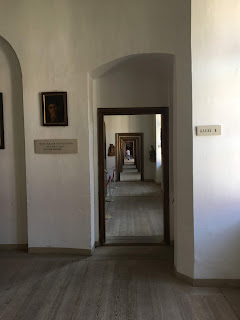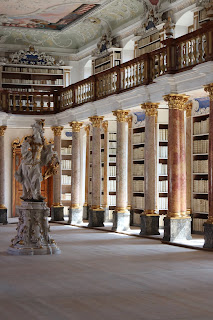 |
| By Diego Delso, CC BY-SA 4.0, https://commons.wikimedia.org/w/index.php?curid=93730681 |
Ottobeuren has a special place in my affections. On Sunday 17 August 1969 at 3.00 pm my friend Keith and I were to have heard Schubert's Unfinished Symphony and Bruckner's 7th Symphony with the Vienna Symphony Orchestra there under Josef Krips. It never happened because we had to change the holiday dates! The prebooked tickets were returned and money back. I have still got the paperwork.
I was a Bruckner/Mahler fanatic for many years, well before the surge of interest in the UK. I often wonder what Bruckner 7 would have sounded like in the basilica at Ottobeuren. Perhaps the performance of a lifetime. Never mind, I heard all the great Brucknerians later in London. Eugen Jochum was my great favourite. Anyway enough of that : I never got to Ottobeuren until March 1989. I had no idea that the abbey was part of the experience, but I knew all about the organs and heard a little of those. It was imperative to go back and take a more leisurely look in August 2019 just over 50 years later!
 |
| Ottobeuren in 1766 |
Ottobeuren is one of the most famous Baroque abbey churches in Germany. The whole complex of convent and church has been described as the Swabian Escorial. It would be better to think of the whole complex as a cross with the church as the bent head of Christ, the domestic buildings as the legs, the monastery as the trunk, administration the right hand and hospitality the left hand.
Ottobeuren was founded in 764 as a Benedictine foundation and grew to become an Imperial abbey in 1299. Disastrous fires and loss of sovereign power to the Archbishop of Augsburg, plus damage in the Thirty Years War meant that it had a chequered history until 1710. The reign of Abbot Rupert Ness (1710-40) ushered in the great period and this lasted until the dissolution in 1802. Ness set about rebuilding the abbey 1711-25 and the church in 1737. The latter was finished by his successor Anselm Erb in 1766.
I do not intend to go into the building history. Suffice it to say that JM Fischer did not design all the abbey or church but did play a crucial part in the planning and execution of the church. It is a basilica wall pillar church with two bay nave, developed absidal transepts, with a conical roof over the crossing, two bay square ended choir and twin towered facade. Comparison with Salzburg Cathedral and Weingarten is interesting. The exterior .to me is noble and imposing and unusual in that it protrudes from the monastic complex.
The interior is overwhelming, a vast open space invigorated by a sea of colour. Yet despite the mass of detail I feel the architecture is not concealed. The form can still be seen through the decoration. The domes are real domes, although not as pronounced as Weingarten or Wiblingen.
The ceiling frescoes by Johann Jakob Zeiller (1710-83) and Franz Anton Zeiller (1716-94) are outstanding. There is the Trinity and Redemption of Mankind over the high altar, God the Father and 9 choirs of Angels over the Choir, the Coming of the Holy Spirit at Pentecost over the crossing, St Feilicity and her 7 sons and the Stairs of Grace in the transepts Benedic tine heaven over the nave and Millennial Ottobeuren over the west gallery. The scale and detail of these has escaped me. Several hours with binoculars followed by compulsory neck and back massage was needed.
Stucco work is mainly by Johann Michael Feichtmayer.
Choir stalls are by M.Harmann and J.Christian. Most notable are the two organs by the master French organ builder Karl Josef Riepp (1710-1775)which are built into the choir stalls. This double organ is one of the most treasured historic organs in Europe. It was the main instrument for 200 years, until 1957 when a third organ (Mary organ) was added in the west gallery by G. F. Steinmeyer & Co, renovated and augmented in 2002 by Johannes Klais, making 100 stops available on five manuals plus pedals.
 |
| Benedictine heaven by FA and JJ Zeiller |
 |
| In centre Pentecost cupola fresco by FA and JJ Zeiller |
 |
| Holy Cross altar and Holy Spirit organ |
 |
| View to Mary Organ in gallery |
The Museum in the abbey buildings is very large and fascinating.
 |
| Grand entrance up to Abbey museum |
 |
| Corridor to the Abbot's suite of rooms |
 |
| Ceiling above entrance staircase |
 |
Franz Anton Zeiller , brother of Johann Jakob,
creator of the ceiling frescos |
 |
| P. Ulrich Schiegg, (1752-1810)mathematician and astronomer |
 |
| Model : Presumably Ulrich Schiegg at work |
 |
| Library corridor |
 |
| Library by JB Zimmermann 1718 |
 |
| Library |
 |
| Ornamental stove |
 |
Doorway into Abbot's quarters
|
 |
| Fireplace in Abbot's quarters |
 |
| Abbot's reception room |
 |
| Abbot's reception room |
 |
| Abbot's living room or Eustachiuszimmer |
 |
| Abbot's living room or Eustachiuszimmer |
 |
| Apothecary |
 |
| Schreibschrank or writing cupboard or bureau |
 |
| Last supper |
 |
| Museum corridor |
 |
| Abbot's chapel |
 |
| Abbot's chapel |
 |
| Ceiling of the Theatre |
 |
| Theatre ; unfortunately full of exhibition items |
 |
| Kaisersaal |
Kaisersaal
 |
| Ceiling of the Kaisersaal :Coronation of Emperor Charlemagne by the Pope. |
 |
| Ceiling of main staircase leading to Kaisersaal |
 |
| Staircase to Kaisersaal |
 |
| Staircase to Kaisersaal |










































No comments:
Post a Comment